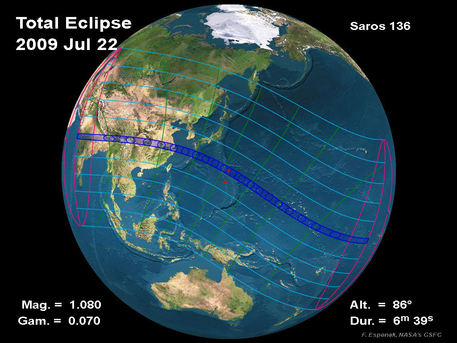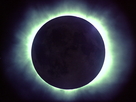Longest Solar Exlipse of the 21st Century
When do Solar and Lunar eclipses occur?
 © F. Espenak, NASA's GSFC |
The light blue lines show the course of the eclipse zones of various successive solar eclipses of Saros family 136. These eclipse zones move in a spiral pattern across Earth's surface at 18-year intervals. The path of the totality zone (the Moon's umbral shadow) of the solar eclipse on July 22, 2009 is shown in dark blue. A partial eclipse (penumbral shadow) is visible over a much wider area, including most of eastern Asia, Indonesia, and the Pacific Ocean.
In the past, eclipses were interpreted as a sign of fate. Even the ancient Babylonians knew the rules of celestial mechanics, which can be used to forecast solar and lunar eclipses. They found out that eclipses of similar types happen successively at an interval of 18 years, 10 days and 8 hours (when there are five leap years in the intervening period). This special sequence of eclipses is known as the 'Saros cycle' (there are other eclipse cycles as well.) After a 'Saros period' – that is, after 18 years, 10 days and 8 hours – the Moon, Earth and Sun again assume the same positions relative to each other and solar and lunar eclipses again take place under almost exactly the same conditions. A Saros cycle is one day longer (18 years, 11⅓ days) if it only contains four leap years and two days longer (18 years, 12⅓ days) if only three leap years occur.
Patterns of solar and lunar eclipses
During a solar eclipse the Moon moves between the Sun and the Earth and throws its shadow on parts of the Earth’s surface. Many people will remember the solar eclipse on August 11, 1999, which could be observed in Europe – it will have a 'daughter eclipse' on August 21, 2017, exactly 18 years, 10 days and 8 hours later. During those eight 'extra' hours, the Earth will have turned approximately 120 degrees longitudinally, from west to east – and for this reason this eclipse will be viewable over the North American continent. It will also have shifted a little southward.
The next solar eclipse in this series will take place on September 2, 2035 in the Asia-Pacific region, in turn again having shifted around 120 degrees west and a little further south. This solar eclipse is thus the daughter eclipse of the daughter eclipse and this is why, in addition to Saros cycles, there are also 'Saros families'. For each Saros family, the 'matriarch' of the family appears near one of the Earth's poles as a partial solar eclipse. The eclipse zones of subsequent family members then move in a spiral pattern across Earth's surface at 18-year intervals until the very last descendant of a Saros family arrives at the Earth’s other pole around 1300 years later and that 'Saros dynasty' becomes extinct after approximately 70 eclipses.
German Aerospace Center
Longest Solar Exlipse of the 21st Century
When do Solar and Lunar eclipses occur?
 © F. Espenak, NASA's GSFC |
The light blue lines show the course of the eclipse zones of various successive solar eclipses of Saros family 136. These eclipse zones move in a spiral pattern across Earth's surface at 18-year intervals. The path of the totality zone (the Moon's umbral shadow) of the solar eclipse on July 22, 2009 is shown in dark blue. A partial eclipse (penumbral shadow) is visible over a much wider area, including most of eastern Asia, Indonesia, and the Pacific Ocean.
In the past, eclipses were interpreted as a sign of fate. Even the ancient Babylonians knew the rules of celestial mechanics, which can be used to forecast solar and lunar eclipses. They found out that eclipses of similar types happen successively at an interval of 18 years, 10 days and 8 hours (when there are five leap years in the intervening period). This special sequence of eclipses is known as the 'Saros cycle' (there are other eclipse cycles as well.) After a 'Saros period' – that is, after 18 years, 10 days and 8 hours – the Moon, Earth and Sun again assume the same positions relative to each other and solar and lunar eclipses again take place under almost exactly the same conditions. A Saros cycle is one day longer (18 years, 11⅓ days) if it only contains four leap years and two days longer (18 years, 12⅓ days) if only three leap years occur.
Patterns of solar and lunar eclipses
During a solar eclipse the Moon moves between the Sun and the Earth and throws its shadow on parts of the Earth’s surface. Many people will remember the solar eclipse on August 11, 1999, which could be observed in Europe – it will have a 'daughter eclipse' on August 21, 2017, exactly 18 years, 10 days and 8 hours later. During those eight 'extra' hours, the Earth will have turned approximately 120 degrees longitudinally, from west to east – and for this reason this eclipse will be viewable over the North American continent. It will also have shifted a little southward.
The next solar eclipse in this series will take place on September 2, 2035 in the Asia-Pacific region, in turn again having shifted around 120 degrees west and a little further south. This solar eclipse is thus the daughter eclipse of the daughter eclipse and this is why, in addition to Saros cycles, there are also 'Saros families'. For each Saros family, the 'matriarch' of the family appears near one of the Earth's poles as a partial solar eclipse. The eclipse zones of subsequent family members then move in a spiral pattern across Earth's surface at 18-year intervals until the very last descendant of a Saros family arrives at the Earth’s other pole around 1300 years later and that 'Saros dynasty' becomes extinct after approximately 70 eclipses.
German Aerospace Center






